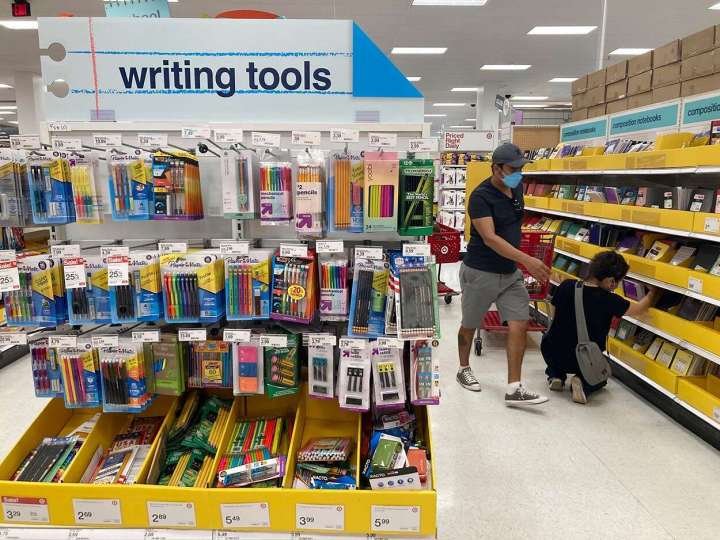The back-to-school bins in Jonelle Wood’s attic have been full since the end of June, with enough paper, pencils and clothing to last her three school-age children into next fall. All for $245.
How families are surviving the high cost of back-to-school season

Many Americans have become similarly savvy as they work through their back-to-school lists in this era of raging inflation, Deloitte and JLL research shows. They are tracking sales, flocking to discount stores and working extra shifts. Many also started shopping months earlier than usual to get ahead of a season that the National Retail Federation estimates will run the typical U.S. household $864.
They also are paying attention to the industry, said Chip West, a retail and consumer behavior expert at the marketing solutions company Vericast. The supply chain bottlenecks that once plagued retailers have given way to inventory pileups for many big-box stores, forcing them to slash prices to clear out the excess.
“They know that there’s more deals to be had out there,” West said. “They’re looking for more of those promotions and sales and coupons to help them save money.”
The stakes are high for retailers: Americans spent a record $37 billion in 2021, according to the National Retail Federation, which expects comparable numbers this year.
While government data showed consumer spending climbed a healthy 1.1 percent in June, consumer sentiment — as measured by the University of Michigan — hit a record low of 50 that month. Because consumer spending makes up more than two-thirds of the U.S. economy, economists and policymakers are closely watching for any sign of retrenchment and possible recession.
The season is also a barometer for the crucial holiday shopping season, West said. If families can cover costs for the new school year, they’re more likely to spend during the holidays, especially if they start shopping early and spread out costs over several months.
“As long as inflationary pressures remain high, the consumer behavior and sentiment we are witnessing for back-to-school shopping could easily carry over into the holiday shopping season,” he said.
But Stephen Rogers, managing director of Deloitte’s Consumer Industry Center, said consumers will spend despite higher prices — inflation jumped 9.1 percent in June, year over year — because they view school-related expenses as necessities.
“Parents will always make it happen for their kids,” he said.
Michelle Cain, the mother of a 9-year-old and 6-year-old twins in a Chicago suburb, is meticulous in her search for bargains. She keeps a spreadsheet of the items her children will need and employs research techniques normally reserved for big-ticket purchases such as a car or an appliance. Going item by item, Cain compares prices at Walmart, Target, Amazon and any other stores running big sales, she said, and adds them to the cart before deciding whether it’s worth buying them all at one place or shopping at multiple stores.
Cain, 40, routinely shares her findings in Facebook groups — notifying parents when backpacks are half off or markers are marked down a few dollars — and stretches her shopping between pay cycles. Not including clothes, Cain says she spent about $100 per child this year.
A survey from JLL found that nearly 60 percent of shoppers plan to look for sales and coupons this year, and 50 percent will focus on essential items and buy less. Discount retailers are attracting new customers, including those who have never shopped at a dollar store before, West said. In May, both Dollar General and Dollar Tree raised their sales forecasts for 2022, bolstered by changing shopper habits due to inflation.
Amanda Frey, 39, said she cut out unnecessary expenses when shopping for her 8- and 16-year-old this summer. Unlike other years, when the children would get a fresh pair of shoes and glossy folders with patterns and characters, this year they’ll have to wear the ones they already own and use plain notebooks. She also sifted through their closets to make a list of things they absolutely needed. Even then, she chose the most cost-effective shopping option.
“My daughter shopped at consignment shops where I had credits from turning in her older clothes, instead of shopping for new things,” said Frey, who lives in St. Marys, a town of about 18,000 people in southeastern Georgia.
Wood, 36, of Oklahoma, has been taking full advantage of the big markdowns. She said she found her 16-year-old son’s favorite pants at Walmart for $1 a piece.
“He’s got 15 pairs,” Wood said. “A couple bigger and then some that fit him now.”
The supply chain disruptions of 2021 that left the school supplies aisles bare and led to back orders for computers and tablets shouldn’t be an issue this year, said Darcy MacClaren, the head of digital supply chain at SAP North America, because manufacturers and stores are more prepared.
“Technology [and] your basic school supplies are pretty stable,” she said, and should be readily available. But discounts could fall away as the summer comes to a close and stores stop restocking seasonal aisles.
Cain, of suburban Chicago, said that in years past, she didn’t always have to be as purposeful about shopping deals — she works part time as an office administrator and her husband has a well-paying job in marketing. But higher gas and grocery prices have put a strain on her family.
“If it’s a problem for us, I can’t imagine what it’s like for people who aren’t in the financial situation that we are and don’t have access to the stores we do,” she said.






